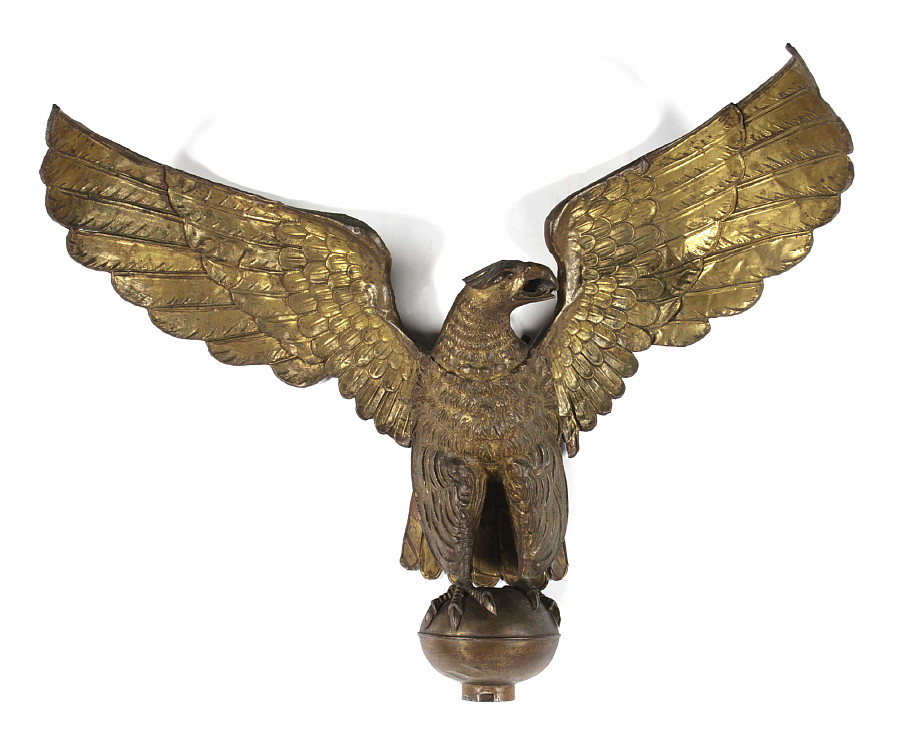
| |
LARGE AND IMPRESSIVE MOLDED COPPER EAGLE, AN EARLY PARADE TORCH & MILITARY HALL DECORATION, MADE IN NEW YORK, SIGNED "H. FACHS", PATENTED 1891 |
| |
|
| Dimensions (inches): |
39" tall x 50" wide x 24" deep |
| Description: |
|
Molded brass and copper eagles of this nature decorated the interiors of Civil War veterans' halls, armories, customs houses and other public buildings. They began to appear during the last quarter of the 19th century and production probably persisted until around 1910. Their structures are partially hollow-bodied and three-dimensional, reinforced with tin on the reverse. They typically have rectangular brackets on the reverse , into which patriotic bunting could be tucked, and/or open tubes, into which the wooden staffs of parade flags could be affixed to fan out above the eagle's wings. Their surface was commonly gilded in gold leaf to give them a rich luster.
Dramatic is the first word that comes to mind of this particular example, which is among a small group that comprises the largest and the most impressive that I have ever encountered. Much of the original gilding remains and the untouched, naturally aged surface is among this sculpture's strongest attributes. Note the sweeping profile of the wings that arch around the beak. The wings are spread as if the bird is landing on the large, flattened orb, gripped within its talons. The combination of the profile, the scale, the detail, and wonderful patina lend a stunning visual impression.
Three examples in this style are presently known. I have owned two and the third resides in the collection of the New York Historical Society. This example and the NYHS example are signed by the maker, H. Fachs. The third is patent-dated 1891 but is unsigned. Henry Fachs is known to have operated in New York City at several addresses during the last quarter of the 19th century. He was listed as a tailor in 1883 at 139 Elm St., as a military dealer from 1884-1889 at the same address. He was listed as a dealer in theatrical goods between 1887 and 1890 at 169 Elm, a dealer in armor between 1991 and 1996 at 654 Hudson, and thereafter as a costumer at 343-345 W. 37th St. until at least 1900.
This example is marked with a small, rectangular piece of copper on the shaft below the squashed globe, stamped with the following characters: "H. FACHS MAKER N.Y." The unsigned example is marked with a small, rectangular, tin plate on the reverse, stamped with an oval, braided rope border, inside which is the following text: "Patented Septr. 15, 1891 NY". A New York mark always a positive feature in the antiques marketplace. An eagle standing on a globe is New York symbolism and appears on the state seal.
This example and the one at the NYHS both have an open shaft that protrudes vertically through the squashed globe.* This is made in such a way that a canister filled with whale oil could be fit inside from underneath, with a wick at the top that could be lit and a wooden pole underneath. These would allow the eagle to be carried as a massive parade torch. In early illustrations, eagles like this one appear as finials atop large parade banners, carried for political campaigning and other patriotic activities.
When the torch was not in use, the organization that owned it -- more likely than not a Civil War veteran's unit -- might hang it prominently on the wall inside their meeting hall. On the reverse between the wings there is an array of five tubes that could each accommodate a printed flag on a wooden staff, so American flags could be inserted above it. Patriotic bunting is often seen draped around and across eagles of this sort in early photos and illustrations for further effect.
Condition: There is expected wear from age and use, including minor dents, losses, and surface loss. The bracket on the reverse was re-attached by means of chemical weld and there is a small, old solder repair on the edge of the tail. The structure is remarkably sound and intact, especially considering its size and lightweight materials.
* It is interesting to note that the third, unsigned example is basically identical, with the exception that its globe is closed at the top and bottom. It also has a flat, hollow tube, made of tin, that protrudes out the back at a 90 degree angle to its vertical axis. This probably served two purposes: one, it could accept a piece of flat iron that could be affixed to a wall bracket for hanging and two, the design would easily accommodate a flat wick. With minor alteration the globe could be connected and serve as a vessel for holding oil. |
|
|
| |
|
| Primary Color: |
gold, copper |
|
| Earliest Date: |
1890 |
|
| Latest Date: |
1899 |
|
| For Sale Status: |
Sold |
|
| Price |
SOLD |
|
| E-mail: |
info@jeffbridgman.com |
|
 |
|
Page Views:... 7930 |
|


